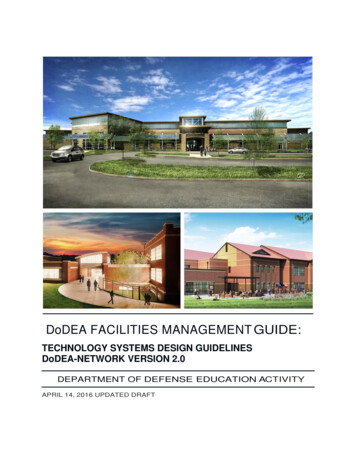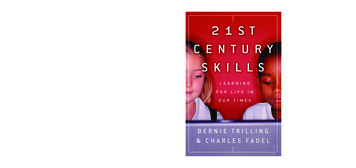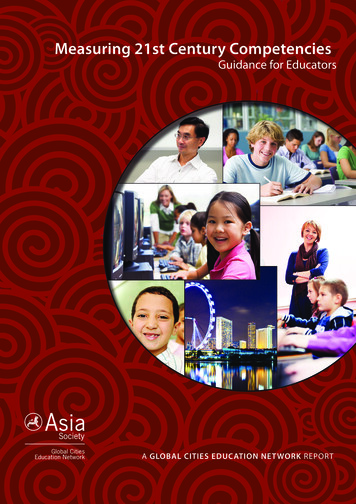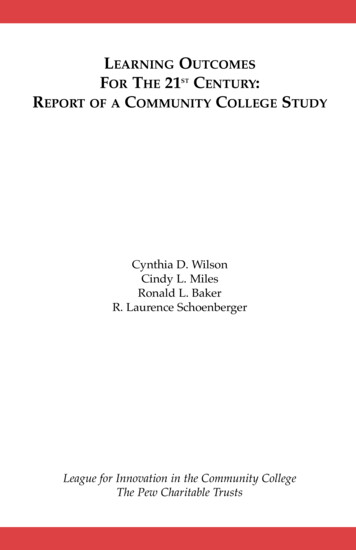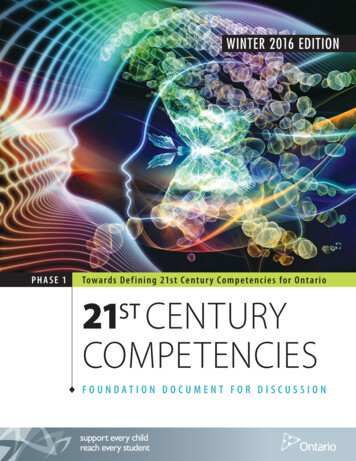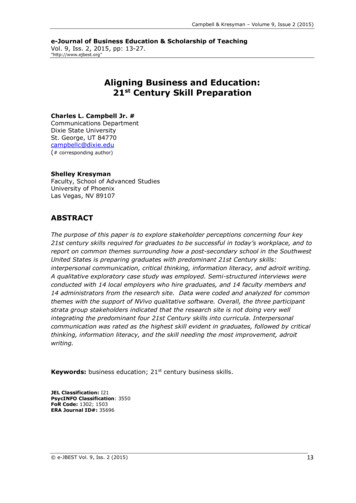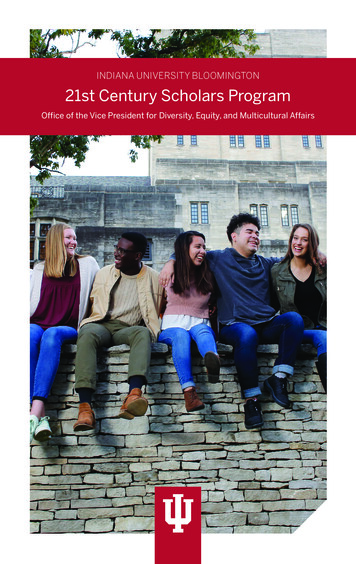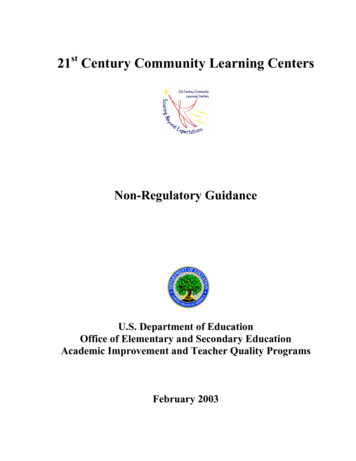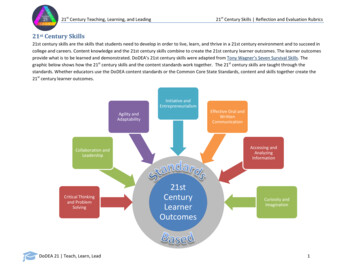
Transcription
21st Century Teaching, Learning, and Leading21st Century Skills Reflection and Evaluation Rubrics21st Century Skills21st century skills are the skills that students need to develop in order to live, learn, and thrive in a 21st century environment and to succeed incollege and careers. Content knowledge and the 21st century skills combine to create the 21st century learner outcomes. The learner outcomesprovide what is to be learned and demonstrated. DoDEA’s 21st century skills were adapted from Tony Wagner’s Seven Survival Skills. Thegraphic below shows how the 21st century skills and the content standards work together. The 21st century skills are taught through thestandards. Whether educators use the DoDEA content standards or the Common Core State Standards, content and skills together create the21st century learner outcomes.Initiative andEntrepreneurialismAgility andAdaptabilityAccessing andAnalyzingInformationCollaboration andLeadershipCritical Thinkingand ProblemSolvingDoDEA 21 Teach, Learn, LeadEffective Oral uriosity andImagination1
21st Century Teaching, Learning, and Leading21st Century Skills Reflection and Evaluation RubricsCritical Thinking and Problem SolvingCritical Thinking and Problem Solving is a habit of mind characterized by the comprehensive exploration of issues, ideas, artifacts, and events aswell as applying knowledge and skills in practical ways to solve real world problems.Initiative and EntrepreneurshipInitiative and Entrepreneurship denote creative, inventive and resourceful ways individuals use to solve problems, search out, and strive for newinnovations.Effective Oral and Written CommunicationOral communication is a prepared, purposeful presentation designed to increase knowledge, to foster understanding, or to promote change inthe listeners' attitudes, values, beliefs, or behaviors. Written communication is the development and expression of ideas in writing. Writtencommunication involves learning to work in many genres and styles. It can involve working with many different writing technologies, and mixingtexts, data, and images. Written communication abilities develop through iterative experiences across the curriculum.Collaboration across Networks and Leading by InfluenceCollaboration across networks is the ability to work together with diverse groups to facilitate the exchange of ideas to achieve a goal, makedecisions, and solve problems. Leading with influence is the ability to generate results collaboratively, in a variety of contexts without directauthority.Agility and AdaptabilityAgility and adaptability is being able to constantly adjust to changing demands by using a variety of tools to solve complex problems withresponsiveness and flexibility. Handling disruption, rapid transformation, and reorganization of information is necessary for 21st centurylearning: “Learning to be comfortable with being uncomfortable”.Accessing and Analyzing InformationAccessing and analyzing information is the ability to know when there is a need for information and how to identify, locate, evaluate andeffectively use that information for solving problems.Curiosity and ImaginationCuriosity and imagination is the capacity to synthesize existing ideas and to work creatively in ways characterized by innovation and divergentthinking.DoDEA 21 Teach, Learn, Lead2
21st Century Teaching, Learning, and Leading21st Century Skills Reflection and Evaluation RubricsReflection and EvaluationOnce the learner outcomes and the 21st century skills are established, they move to the Reflection and Evaluation section of the learning cycle.The learner(s) reflect on what they know by using the Reflection rubrics (teachers and students) or self-assessment tools (leaders).The Reflection and Evaluation RubricsThere are seven rubrics that align with the seven 21st century skills. (See below)The seven Reflection and Evaluation rubrics are designed for teachers and their students to use at the beginning of a lesson design and again atthe end of the lesson cycle to evaluate the progress of learners after applying the 21st century skills to their work. Each rubric supports thegrowth of a student-centered classroom where students become more engaged in the learning process and can apply the learner outcomes(knowledge and skills) to the real world. The reflection section drives the educator’s decision for instructional practice professional learning andselection. The goal is to move from the entry level of development of the skills to the ideal/target level for both teachers and students.Copyright:Rubrics adapted from Bionic TeachingLink: http://bionicteaching.com/?p 1129DoDEA 21 Teach, Learn, Lead3
21st Century Teaching, Learning, and Leading21st Century Skills Reflection and Evaluation RubricsCRITICAL THINKING & PROBLEM SOLVINGStudents will apply knowledge and skills in practical ways to solve real world problems. The teacher provides the activities, experiences, andfeedback needed for students to develop critical thinking and problem solving eacher:Ideal/TargetTeacher:. disseminatesinformation withlimited real worldconnections.places little emphasison helping studentsthink and analytically,make decisions, andsolve problems. provides directinstruction oncritical thinkingand problemsolving skills.createsopportunities forstudents to solvebasic problems. incorporates problem and projectbased learning into instruction.utilizes open-ended questionsand emphasizes higher orderthinking skills.guides and encourages the use ofappropriate resources to solveauthentic problems.Students: Students: use resourcesincluding technologyto make decisionsand solve problems.DoDEA 21 Teach, Learn, Lead use technology and workindependently to solveproblems.engage in open-endedlearning experiences thatrequire higher order thinkingskills. provides real-world opportunities for problem solvingthat utilize multiple solutions.provides structure that allows students to ask open-endedquestions and formulate and articulate solutions toproblems.utilizes a variety of learning activities that allow studentsto choose and engage in solving authentic, relevantproblems.Students: use multiple resources to plan, design, and execute realworld problems. use technology to collaborate and solve authenticproblems. develop and answer open-ended questions using higherorder thinking skills. Identifies a problem, opportunity or challenge with a fullunderstanding of level of complexity. Understands and articulates patterns, cause/effectrelationships and critical indicators related to the currentsituation problem.4
21st Century Teaching, Learning, and Leading21st Century Skills Reflection and Evaluation RubricsINITIATIVE & ENTREPRENEURSHIPStudents will be self-directed in determining ways to seek out new opportunities ideas, and strategies for improvement. Teachers will create a student-centeredclassroom that provides multiple opportunities for students to be self-directed learners.EntryTeacher: DevelopingTeacher:disseminatesinformation withlimited studentengagement.utilizes primarilytraditionalinstructionalmethods in theclassroom (lecture,direct instruction,etc.). providesinstruction toaccommodate arange of learningstyles, interestand capabilities. creates limitedentry points andavenues forlearning.Students: use theirindividuallearning stylesto discoverways toapproachproblemsolving.DoDEA 21 Teach, Learn, LeadApproachingTeacher: creates student –centered tasks for allstudents. provides studentsopportunities to learnthrough multiplepathways/entry points.Students: begin usingcreativeapproaches toproblem solvingthrough theirindividual learningmodes.Ideal/TargetTeacher: creates student-centered learning experiences through multiplepathways and venues on regular basis.provides an opportunity for students to use data and self-reflect ontheir learning, set their own goals and inform their instruction.provides constructive feedback to students on a continuous basis andallows students opportunities to reflect, modify and improve.uses entrepreneurship as a real-world context to have studentsdemonstrate the importance of academic content.Students: use data to set learning goals and self-monitor progress. utilize time and manage workload efficiently. explore and expand one’s own learning and opportunities togain expertise beyond basic mastery of skills and/orcurriculum.reflect critically on past experiences in order to inform futureprogress.5
21st Century Teaching, Learning, and Leading21st Century Skills Reflection and Evaluation RubricsEFFECTIVE ORAL & WRITTEN COMMUNICATIONStudents will be able to communicate their thoughts clearly and precisely through energy, passion and authentic voice.EntryTeacher: DevelopingTeacher:initiates ionalinstructionalmethods in theclassroom (lecture, directinstruction, etc.).creates structures forstudents to articulatethoughts and ideasusing oral andnonverbalcommunication skillsin a variety of formsand contexts.integrates multimediaand r: models effectivecommunication.creates structures forstudents to usecommunication for arange of purposes.provides opportunitiesfor students to makeconnections beyondthe classroom. models effective communication in multiple ways and formultiple purposes.provides opportunities for students to make globalconnections.creates structures, provides opportunities and assessesstudent performance.Students: Students:Students: communicateusing a variety oftechniques. workcollaboratively tocreate products.DoDEA 21 Teach, Learn, Lead communicate withaudiences within andbeyond the classroom.frequently collaborateto create products. initiate communication in real and non-real time.articulate thoughts and ideas effectively using oral, written andnonverbal communication skills in a variety of forms andcontexts.listen effectively to decipher meaning,including knowledge,:values, attitudes and intentions.use communication for a range of purposes (e.g. to inform,instruct, motivate and persuade).utilize multiple media and technologies, and know how to judgetheir effectiveness as well as assess their impact.communicate effectively in diverse environments (includingmulti-lingual).6
21st Century Teaching, Learning, and Leading21st Century Skills Reflection and Evaluation RubricsCOLLABORATION ACROSS NETWORKS AND LEADING BY INFLUENCEStudents need the ability to learn and work fluidly understanding how collaboration can be most effective and where their skills can most influence thelearning task.EntryTeacher: provides independentlearning experiencesfor students.utilizes primarilytraditional instructionalmethods in theclassroom (lecture,direct instruction, etc.).DevelopingApproachingTeacher:Teacher: creates structures forstudent to work in groupson products and projects. provides learning opportunities forstudents to network with diverse teams.establishes group norms to facilitateeffective collaboration.Ideal/TargetTeachers: provides opportunities for students to take aleadership role in collaborative projects.provides opportunities for students to makeconnections beyond the classroom in multiplepathways.Students:Students:Students: engage in teacher-ledcollaborative projects. use decision making andproblem solving processbut seek teacher guidanceoften.DoDEA 21 Teach, Learn, Lead collaborate with minimal adultguidance.identify and frequently use outsidecommunity resources to achieveresults.use decision making and problemsolving process. Decisions arediscussed, evaluated and followedthrough with minimal teacherguidance. Results are evident. demonstrate ability to work effectively andrespectfully with diverse teams.exercise flexibility and willingness to behelpful in making necessary compromisesto accomplish a common goal.assume shared responsibility forcollaborative work, and value theindividual contributions made by each teammember.use decision making and problem-solvingskills to influence and guide others towarda goal.7
21st Century Teaching, Learning, and Leading21st Century Skills Reflection and Evaluation RubricsAGILITY AND ADAPTABILITYIn a 21st century classroom, students will think, be flexible and adaptable to change while using a variety of tools to solve problems. Students willunderstand that there can be multiple solutions to a problem. The teacher will ensure that students receive instruction designed to elicit innovative and creativethinking and problem Teacher:Ideal/TargetTeacher:. initiates independentproblem solvingopportunities with asingular solution.provides feedback asneeded.utilizes primarilytraditionalinstructional methodsin the classroom(lecture, directinstruction, etc.). provides studentswith multipletools and ways tosolve problems.provides frequent,descriptivefeedback.providesopportunities totackle bothsimple andcomplexproblems. creates a variety of learning creates conditions that require student demonstration ofopportunities that includeadaptability to change. provides real-world opportunities for problem solving thatchallenges with andutilize multiple solutions.without clear solutions. provides ongoing constructive/descriptive feedback that allows encourages students tofor student to self-reflect, modify and improve.work collaboratively. provides deliberatefeedback to students duringformative and summativeassessments.Students: Students:Students: use a variety oftools andstrategies to solvesimple andcomplex problem.DoDEA 21 Teach, Learn, Lead use problem solvingstrategies that necessitatestudents to workcollaboratively in solvingproblems with multiplesolutions. adapt to varied roles, jobs responsibilities, schedules andcontext.work effectively in a climate of ambiguity and changingpriorities.incorporate feedback effectivelydeal positively with praise, setbacks and criticism.understand, negotiate and balance diverse views and beliefs toreach workable solutions, particularly in multi-culturalenvironments.8
21st Century Teaching, Learning, and Leading21st Century Skills Reflection and Evaluation RubricsACCESSING AND ANALYZING INFORMATIONAccessing and analyzing information is the ability to know when there is a need for information and how to identify, locate, evaluate and effectivelyuse that information for solving problems. In the 21st Century classroom, students find, navigate through, and evaluate large amounts of information.Teachers provide guided and independent research opportunities for students to make informed decisions and create gTeacher:Ideal/TargetTeacher:. provides printresources for researchand informationacquisition.directs student use ofelectronic resources. evaluates electronicresources forappropriateness.utilizes schooldatabases for enhancedresearch andinformationacquisitions. incorporates problem and projectbased learning into instruction.utilizes open-ended questions andemphasizes higher order thinkingskills.guides and encourages the use ofappropriate resources to solveauthentic problems.Students: Students: locate and acquireinformation usingprovided resources.DoDEA 21 Teach, Learn, Lead develop questions to guideresearch.apply research methods tofind and evaluate resources.select information from avariety of digital resourcesand databases. creates structures that guide student inquiry andfacilitates the use of information.provides opportunities for students to access,evaluate, synthesize and use information effectivelyand efficiently to conduct research, solve problemsand manage projects throughout all content areas.provides ongoing constructive/descriptive feedbackthat allows for student to self-reflect, modify andimprove.Students: apply varied research skills to find and evaluateresources. use information and resources to accomplish realworld task. select appropriate digital tools to assemble, evaluateand utilize information. make informed decisions to integrate newinformation to evaluate future materials andformulate solutions to problems.9
21st Century Teaching, Learning, and Leading21st Century Skills Reflection and Evaluation RubricsCURIOSITY AND IMAGINATIONCuriosity and imagination is the capacity to synthesize existing ideas and to work creatively in ways characterized by innovation and divergent thinking. In the 21stCentury classroom, students develop original ideas and create products by applying critical thinking, research methods, communication tools and collaborativeprocesses. Teachers provide experiences that allow students to create unique ideas and gTeacher:Ideal/TargetTeacher:. limits instruction tospecific content.makes connections toexisting knowledge. provides instruction toaccommodate a rangeof learning styles,interests andcapabilities.promotes students toidentify tends, makepredictions and thinkskillfully. creates a student-centeredenvironment.provides opportunities forstudents to demonstratecollaborating, communication,and critical thinking skills.establishes group norms tofacilitate effective collaboration.Students:Students: make connections toexisting knowledge.produce unique andcogent ideas or products,but only with significantguidance andencouragement.DoDEA 21 Teach, Learn, Lead identify trends and makepredictions independently.apply existing knowledge tocreate unique and cogentideas and products withminimum support. creates opportunities for students to elaborate,refine, analyze and evaluate their own ideas in orderto improve and maximize creative effortscollaboratively and independently.provides ongoing constructive/descriptive feedbackthat allows for student to self-reflect, modify andimprove.Students: apply critical thinking research methods andcommunication tools to create original workindependently. collaborate effectively with an audience beyond theclassroom to create original work. demonstrate originality and inventiveness in workand understand the real-world limits to adoptingnew ideas. view failure as an opportunity to learn; understandthat creativity and innovation is a long-term,cyclical process of small successes and frequentmistakes.10
21st Century Teaching, Learning, and Leading21st Century Skills Reflection and Evaluation RubricsStudent Assessment Tools21st Century Skills assessmenthttp://www.cae.org/content/pro collegework.htmCollege and Work Readiness Assessment (CWRA)There is a link to a demonstration task (as well as sample reports and other materials) available ations esentations .Critical Thinking Testing and Assessment (Online test)The International Critical Thinking Basic Concepts and Understandings Test, developed by leading international authorities on criticalthinking, Dr. Linda Elder and Dr. Richard Paul, along with Foundation for Critical Thinking Research Fellow Rush Cosgrove, is the firstcomprehensive and foundational critical thinking concepts and principles test to be developed and offered for online -thinking-testing-and-assessment/594Guide http://www.criticalthinking.org/TGS files/SAM-CT competencies 2005.pdfCritical Thinking ing.aspxAssessing and Analyzing ment/assessmentTools/pdf files/AssessmentToolsdocs.pdfCuriosity and A 21 Teach, Learn, Lead11
21st Century Skills 21st century skills are the skills that students need to develop in order to liv e, learn, and thrive in a 21st century environment and to succeed in college and careers. Content knowledge and the 21st century s kills combine to create the 21st century learner outcomes. The learner outcomes
